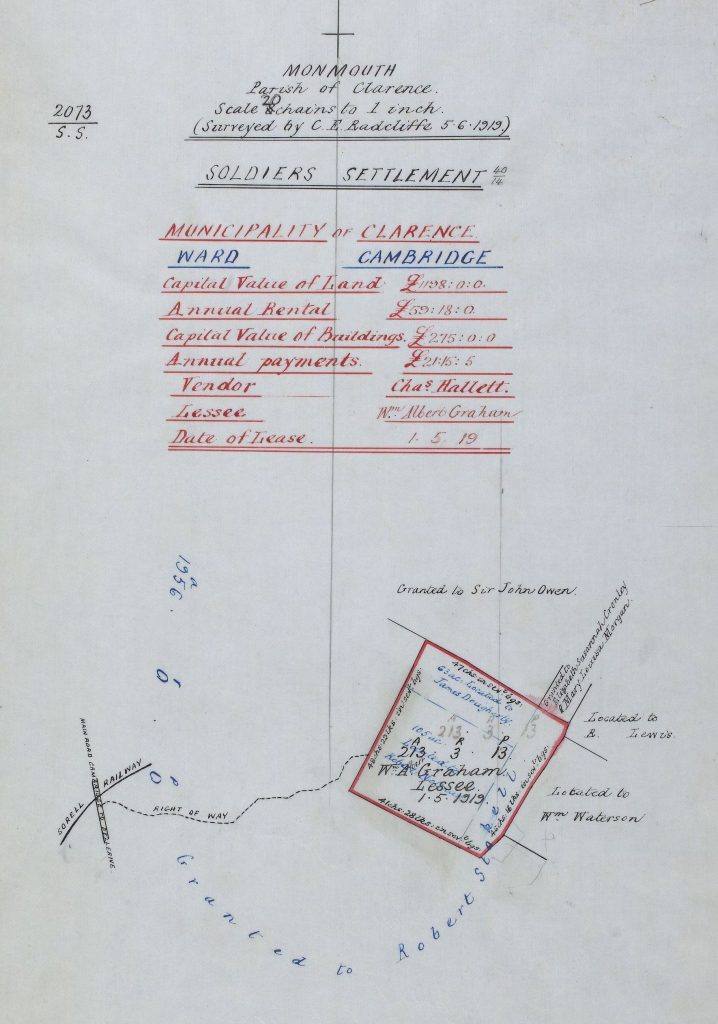Soldier Land Settlement Scheme

The Soldier Land Settlement Scheme was created to help settle returned soldiers on the land after the First and Second World Wars.
“The Returned Soldiers’ Settlement Act, 1916,” and the amending Acts of 1917 and 1918, make provision for the Settlement on land in the State of Tasmania of any returned soldiers with satisfactory discharges, and who have had previous farming experience, desirous of following this occupation. – Government Printer 1919
Libraries Tasmania has a variety of historical records about soldier settlement, many of these available online.
By entering a person’s name you can search the Tasmanian Names Index for applications to lease land under the act from 1917 until 1929 as well as applications for selections of free crown land from 1917 to the 1940s.
Many of these records also contain links to the soldier’s service record through the National Archives of Australia’s Discovering Anzacs portal. If one exists, there may also be a photograph from the Weekly Courier or the Tasmanian Mail.
The Closer Settlement Board was responsible for implementing the Soldier Settlement Scheme and their records are a rich source of information about it.
One soldier who applied for land as part of this act was William Albert Graham, and his descendants still live on the land today.
William enlisted with the Australian Imperial Force at Claremont on the 19/01/1916.
On his return from the war he applied for the Soldier Settlement Scheme on the 15/03/1919.
On William’s application he mentions that he was “wounded with shrapnel but am getting alright”

William’s grandson David Graham talks about when his grandfather enlisted, and the time that he was wounded near the Hindenburg line.
The date on the lease for William’s land was the 1st of May 1919.

His grandson David talks about William and the land where his family still live.
Bibliography
Beresford, Quentin. The World War One soldier settlement scheme in Tasmania [online]. Papers and Proceedings: Tasmanian Historical Research Association, Vol. 30, No. 3, Sept 1983: 90-100. Availability:<http://search.informit.com.au.instance1.ezproxy.education.tas.gov.au/documentSummary;dn=840404145;res=IELAPA>ISSN: 0039-9809. [cited 19 Apr 17] (Log in with your LINC Tasmania membership details)
Richardson, Andrew. Soldier Land Settlement Scheme [online]. The companion to Tasmanian History. Availability: http://www.utas.edu.au/library/companion_to_tasmanian_history/S/Soldier%20settlement.htm accessed 19/04/17
Government Printer (1919) Information for returned soldiers desirous of obtaining land under “The Returned Soldiers’ Settlement Act, 1916”


I would be very grateful indeed if you are able to help me.
My grandfather (Frank Egerton Jackson 18973 – 1920) arrived in Tasmania at the end of Dec 1919. He was a captain in the newly-formed RAF and had recently been demobbed. I understood that he had responded to an offer of farming land open to ex-servicemen. I have a very briefly worded document which states that on 12/02/20 he had made an application for land in Calder Road – ref 2799/0. It may say “80 acres” but the writing is unclear. I had previously understood that the offer was for 200 acres but having searched high and low I’ve not managed to find the reference.
If you are able to shed any light on this “offer” of land and how it would have been made known to someone who’d been in the RAF, I would be most appreciative. He clearly knew about it before arriving in Tasmania. Sadly he died a few months later.
With kind regards,
Caroline
Hi Caroline, we have logged your question with our research service. A researcher from our team will be assigned to look into it and we aim to get back to you within 20 working days.